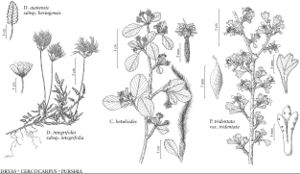Cercocarpus
in A. von Humboldt et al., Nov. Gen. Sp. 6(fol.): 183.
6(qto.): 232.
plate 559. 1824.
Shrubs or trees, (5–) 10–85 [–300+] dm. Stems 1–20, branched distally; bark silvery to dark gray or brownish black, often maroon-brown when young, smooth, roughened in older stems; long-shoots straight or flexuous, short-shoots short-to-elongate, branched or not, sometimes interspersed with long-shoot segments. Leaves persistent or drought or winter-deciduous, abscising distal to leaf-bases and stipules, fascicled on short-shoots, simple; stipules caducous, lanceolate to ovate, margins entire; petiole present; blade narrowly to broadly obovate, oblanceolate, ovate, suborbiculate, elliptic, or lanceolate to linear, (0.3–) 0.5–5 (–7.8) cm, membranous to coriaceous, margins revolute or flat, serrate, dentate, crenate, or entire, abaxial surface hairier on veins, adaxial sericeous, pilose, hirsute, villous, glabrate, or glabrous. Inflorescences axillary, 1–3 (–18) -flowered clusters; bracts of highly reduced leaves or only of leaf-bases; bracteoles of highly reduced leaves or only of leaf-bases. Pedicels present. Flowers 6–15 mm diam.; hypanthium tube greenish yellow or tinged reddish purple, narrowly cylindric, cups hemispheric-campanulate, thin, exterior hairy, interior glabrous, reticulately veined, circumscissially dehiscent from tube after flowering, 1–10 mm, exterior hairy, eglandular; sepals (3–) 5, erect to reflexed, broadly to narrowly deltate; petals 0; stamens 10–61; torus absent; carpels 1 (or 2), stipitate, stigmas lateral. Fruits achenes, 1, cylindro-fusiform, 6–11 (–13.5) mm, chartaceous-coriaceous, strongly veined; hypanthium tube persistent, loosely enclosing achenes, cinnamon brown, 5–10-veined, longitudinally splitting distally as fruit enlarges; sepals and hypanthial cup deciduous. x = 9.
Distribution
w, sc United States, Mexico
Discussion
Species 8 (4 in the flora).
Within Cercocarpus, nuclear DNA sequences and chloroplast DNA regions have been analyzed (B. D. Vanden Heuvel 2002) with support demonstrated for four clades: (1) C. betuloides clade, including all the varieties of C. betuloides; (2) C. ledifolius clade, including three varieties of C. ledifolius; (3) C. montanus clade, including C. breviflorus and C. montanus; and (4) a clade including C. fothergilloides and other Mexican species. The data sets do not resolve the relationships among individual species or varieties within the four clades.
Cercocarpus species are heteroblastic, with new growth occurring in favorable seasons via long shoots, but with most leaves produced on flower-bearing short shoots. All but one species, C. montanus, are evergreen. Long-shoot leaves are larger than short-shoot leaves. Short-shoot leaves are variable in size with the proximal smallest, more ovate, the later-formed larger, often more oblong-obovate. Plants of mesic sites typically have larger, thinner leaves than those of more xeric sites, often with variation present within a mountain range; this is not considered taxonomically important. The small leaves of drier sites are more coriaceous and thicker; the veins have bundle sheath extensions, and the stomata are in depressions. Variation also occurs in vestiture within most taxa, with some plants sericeous-strigose or with hairs ascending to wavy (more or less villous) or erect, other plants having thicker, coiled hairs. These vestiture types may be geographically distributed (and useful taxonomically) or mixed within a population. Short shoots may develop few to many flowers in a cluster; this can be a useful character or be modified by the environment and result in exceptions.
Selected References
None.
Lower Taxa
Key
| 1 | Leaf blades linear, linear-lanceolate, lanceolate, lance-elliptic, or elliptic-ovate, (l/w = 2.5–10), stiffly coriaceous, margins entire, weakly to strongly revolute; anthers glabrous. | Cercocarpus ledifolius |
| 1 | Leaf blades usually ovate to broadly ovate, oblong-elliptic, oblong-obovate, or obovate to narrowly obovate, sometimes oblanceolate to narrowly oblanceolate, oblong-oblanceolate, rhombic, or suborbiculate, rarely lance-ovate, (l/w = 1–3), membranous, subcoriaceous, or coriaceous, margins serrulate, serrate, dentate, or crenate sometimes in distal 1/5–3/4, revolute or flat; anthers hirsute | > 2 |
| 2 | Leaves winter-deciduous, blades ± subcoriaceous (not stiff), ovate to broadly ovate, obovate to narrowly oblong-obovate, or oblanceolate, margins dentate to crenate or serrate (proximal teeth with convex margins, distal teeth smaller, more crowded); Arizona, Colorado, sw Idaho, w Nebraska, se Nevada, New Mexico, w South Dakota, w Oklahoma, nw Texas, Utah, e to s Wyoming. | Cercocarpus montanus |
| 2 | Leaves persistent or drought-deciduous, blades membranous or subcoriaceous to coriaceous, oblong-obovate, rhombic, oblong-elliptic, ovate to broadly ovate, suborbiculate, narrowly oblanceolate, oblong-lanceolate, or narrowly obovate to obovate, rarely lance-ovate, margins dentate, serrulate, serrate, crenate (teeth apiculate), or entire in some C. betuloides var. traskiae; Arizona, California, New Mexico, Oregon, w Texas | > 3 |
| 3 | Stipules (1.5–)3.5–6(–10) mm (1.5–2.5 mm in s California); achene styles: proximal setae 2.7–5 mm; flowering late Feb–Apr(–May); sw, sc Arizona, California, Oregon. | Cercocarpus betuloides |
| 3 | Stipules 1.5–2.5(–3) mm; achene styles: proximal setae 1.5–2.7 mm; flowering late Jun–Aug(–Sep); nc Arizona, New Mexico, Texas. | Cercocarpus breviflorus |
"thin" is not a number."dm" is not declared as a valid unit of measurement for this property.
